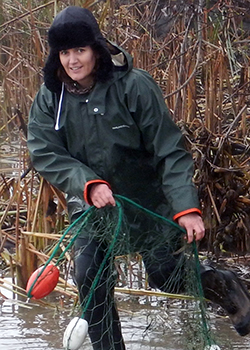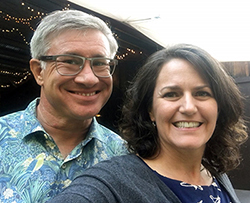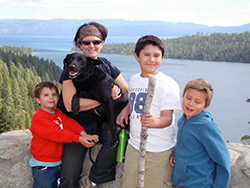
Stacy Sherman conducts fish sampling at Liberty Island in the north Delta.

Stacy and her husband, Marcus, a biology teacher at Stockton’s Stagg High School.

Stacy and her three stepsons – Owen, Jack and Charlie – pause for a photo overlooking Lake Tahoe.
Stacy Sherman is an environmental program manager based in the Bay-Delta Region’s Stockton Field Office. She heads CDFW’s Fish Restoration Program Monitoring Team, a group of eight scientists and staff charged with one specific but important task: monitoring and supporting efforts to restore 8,000 acres of the Sacramento-San Joaquin Delta and Suisun Marsh to tidal wetlands.
The restoration was mandated in 2008 by the U.S. Fish and Wildlife Service to help at-risk fish populations in the Delta as a condition of operating the Central Valley and State Water Projects, which send water to the Central Valley and southern California.
Stacy joined CDFW in 2014 from the University of the Pacific in Stockton where she was an assistant professor of biology for seven years. She was born in Nebraska but raised in Baton Rouge, La. She holds a bachelor’s degree in zoology from Louisiana State University and a Ph.D. in marine biology and fisheries from the University of Miami, where she studied billfish larvae – baby sailfish and marlin – for her dissertation.
Fill us in on the Delta restoration efforts. Where are we in meeting the goal of restoring 8,000 acres to tidal wetlands?
It’s all in the pre-project planning phase. There are a lot of moving parts. The Department of Water Resources (DWR) is the lead agency and it’s DWR’s responsibility to actually do the restoration. Our team is relatively new. We exist to determine whether the restoration is effective and to provide the biological expertise.
DWR has acquired several sites. These are all on public land or properties purchased from willing sellers. Prospect Island in Solano County is one. Bradmoor Island is another. Many already have some marshy areas. DWR will dig out some more and punch some holes in the levees. The first project will probably be breached next year.
What’s so important about making these lands accessible to the tides and tidal influence?
Back before the Gold Rush, all of the Delta was wetland. After the land was reclaimed, we lost something like 97 percent of the marsh. The idea is that the tidal marsh is incredibly productive and our changes to it probably affected the food web. So the requirement to restore so much acreage to tidal wetlands is to increase the availability of food and habitat for listed fish species, particularly the Delta smelt but also salmon. When I talk about it publicly, I try to bring people back to what was here in the past and how productive it is and how a healthy environment is good for everyone.
Did you develop your passion and expertise in wetlands growing up and going to school in Louisiana?
I spent a lot of time on the water growing up, but not necessarily the marsh – mostly lakes. My family started going to this one little lake outside of Baton Rouge when I was like 4. It’s called False River and it’s an oxbow lake off the Mississippi River. We sailed and fished and swam there all the time.
When I was in college, I did some undergraduate research on the coast in the marsh. And my post-doctorate work is all in the marsh. That was actually in South Carolina.
What brought you to California and CDFW?
I decided to try the academic track and ended up in Stockton at the University of the Pacific teaching biology. The university is heavily skewed toward pre-dental and pharmacy so it wasn’t a great fit for me.
One of my former master’s students, Phillip Poirier, who is now my colleague here in the office, sent me this job ad and said, “Do you know anyone who would like to apply for this?” And I said, “That sounds really nice. I will apply for it.”
What do you enjoy most about your job?
I really enjoy getting together with smart people here who care about the estuary and want to see it improved. I get the chance to work with people within CDFW and across other agencies, nonprofits, consulting firms, and it’s really nice to see people working together toward the same goal. We might have differences of opinions but we are all trying to get to the same place.
California’s education leaders are concerned about the lack of girls and young women studying science and pursuing science and technology careers. Do you have any advice for them?
I think the key for any kid is to get them engaged, get them outside. Don’t give them answers. Give them a chance to work things out – some of the inquiry-based science.
My husband actually teaches high school biology at Stagg High School in Stockton and we talk about this a lot. He takes his students out to the Calaveras River, which runs right through Stockton. Experiences like that for me – hands-on, getting outside, answering questions, being able to be creative – is what made this field really attractive.
When I was in middle school, the public school I attended offered marine biology and that was my first time to a marine lab and an overnight field trip. And then at LSU, I had all of these great field experiences and a really great ichthyology professor who kind of nudged me and encouraged me along the way.
You have a unique perspective as an educator and now as a CDFW manager trying to hire scientists. Are universities doing enough to prepare the next generation of natural resource scientists?
I think it’s variable. There are places that do have strong programs that really do prepare students well. I’ve had some amazing staff. We had a scientific aide here, Sunny Lee, who graduated from UC Santa Barbara and he came in with just so many skills – good writing and he already knew a bunch of invertebrates. He caught on to our process really quickly so that was great. On the other hand, you see applications from those who graduated with a degree in environmental studies – environmental science majors even – who say, “This will be a really great job for me. I really want to do this and get outside.” And I don’t think some of those applicants necessarily grasp the rigor involved – that this is serious science and it’s not just playing around outside.
What advice would you give a young person thinking about a career in natural resources?
Talk to people in the field before you make a decision about your school or the program you want to study. Go out and volunteer if you can. Make contacts. I would recommend they pay a lot of attention to math and statistics especially. Get used to working hard. Be the hardest worker in the room as that’s what’s going to get you along.
Tell us something about yourself many people would be surprised to learn.
Most people are surprised to find out I’m part Cajun. My mom is Cajun. I get a lot of questions about my lack of accent.
All photos courtesy of Stacy Sherman